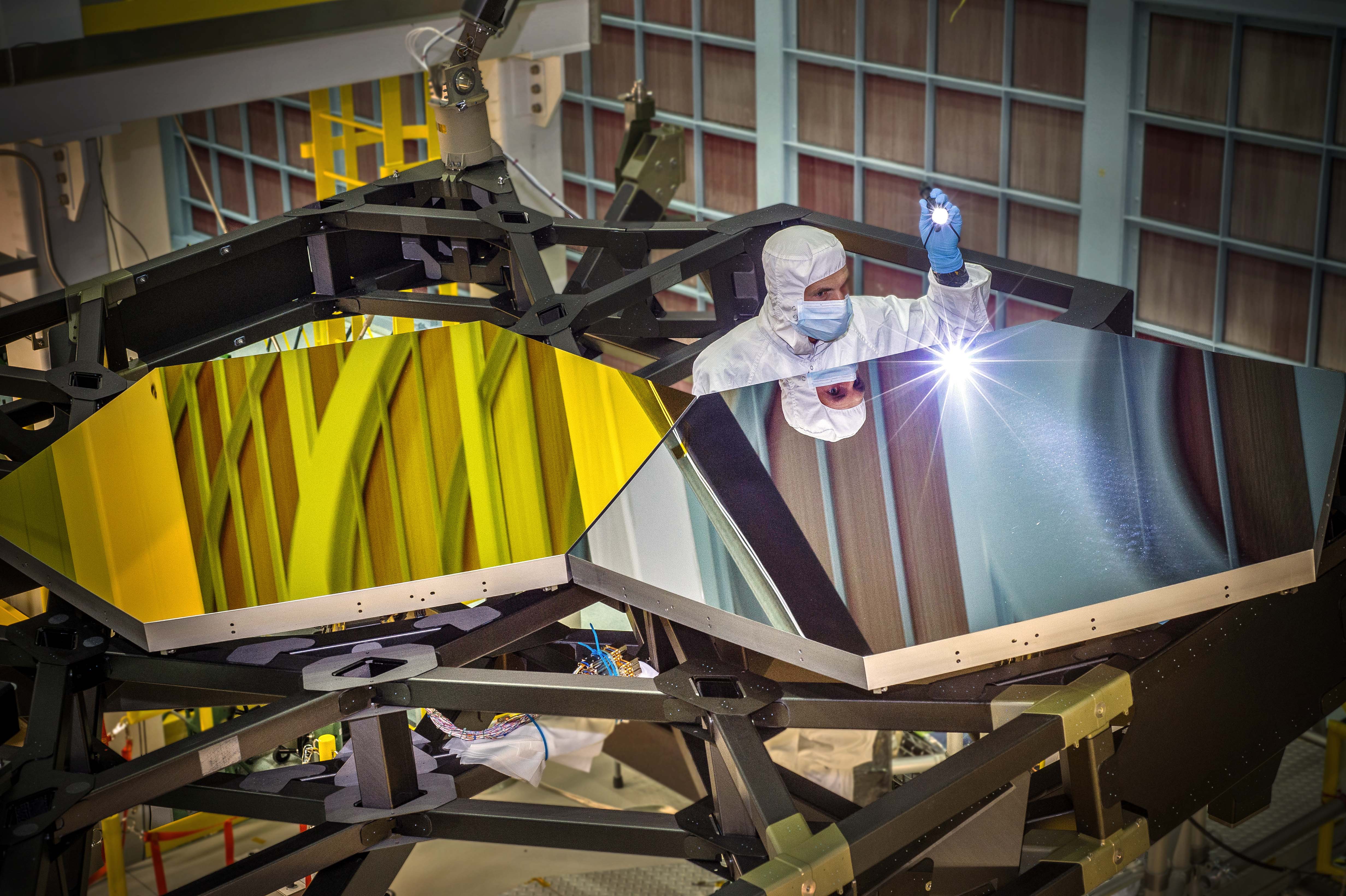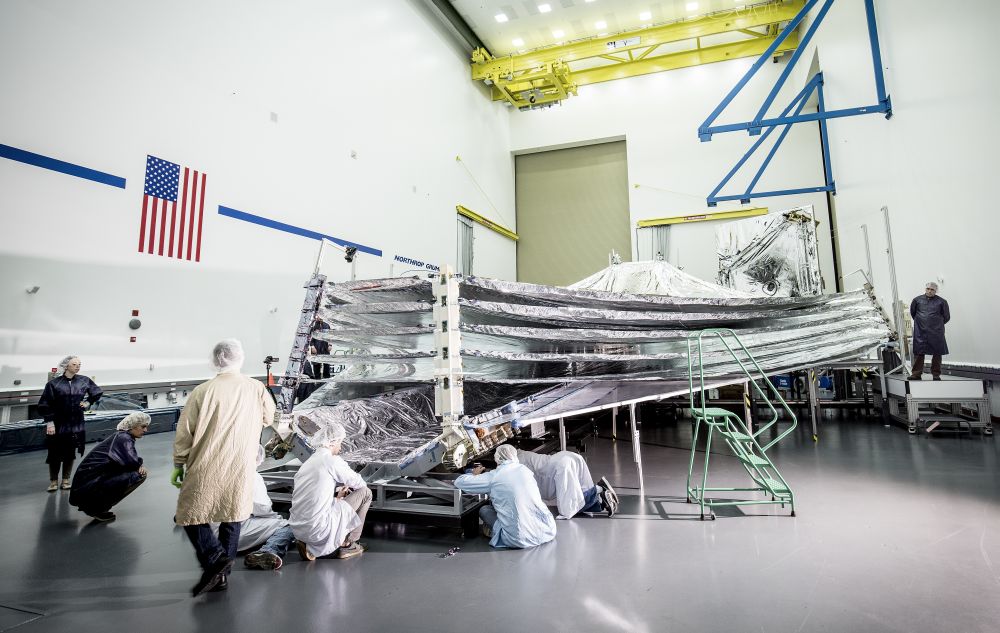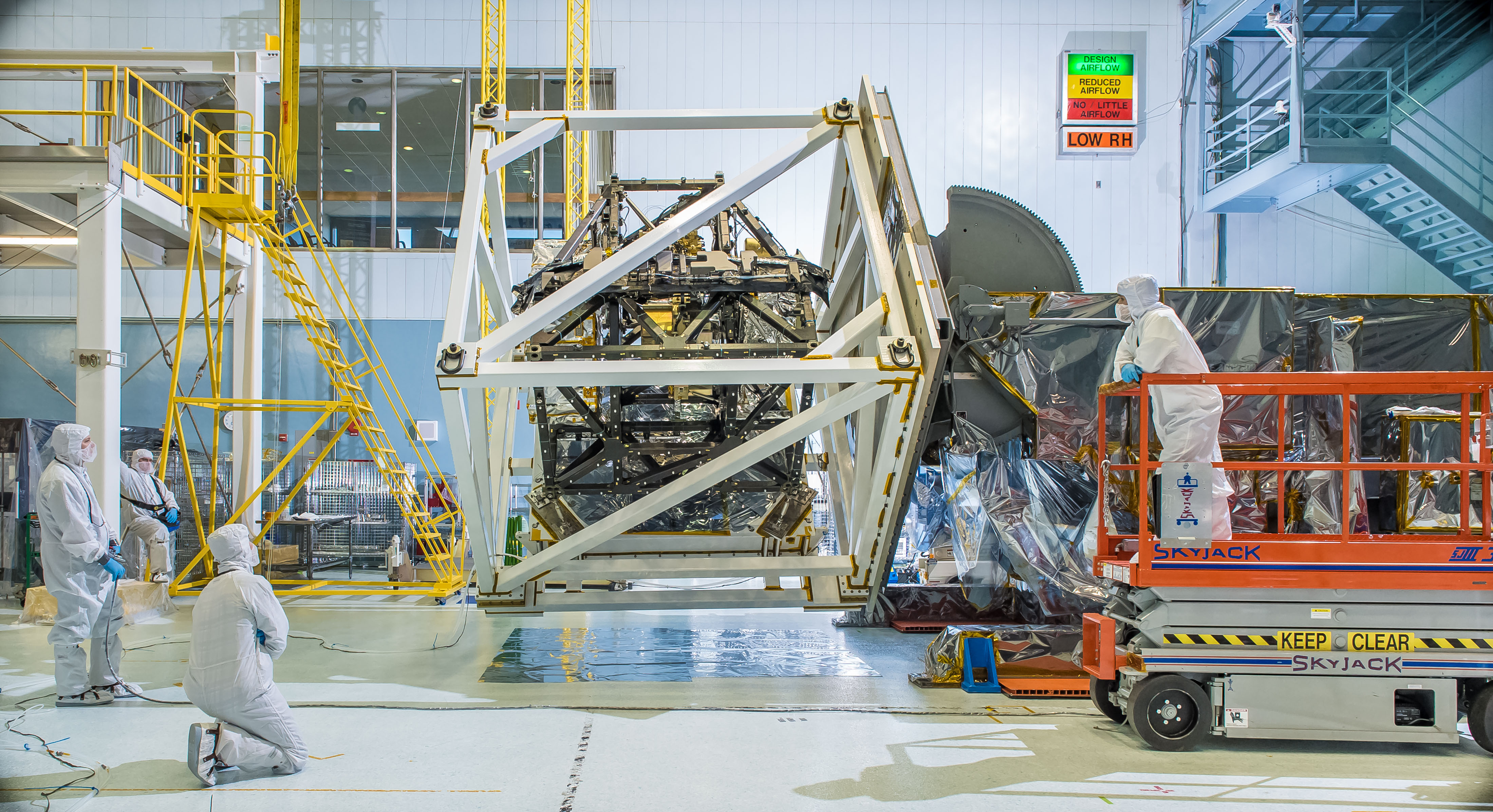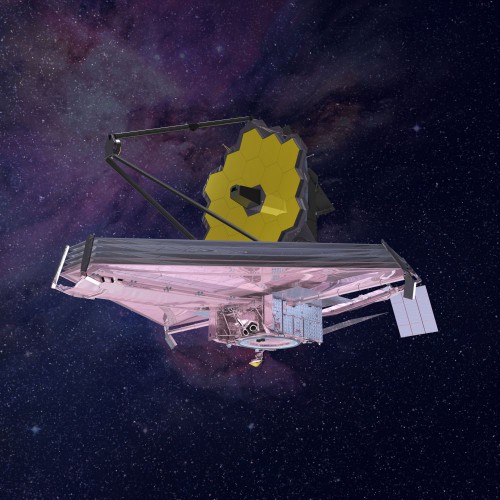
While the Hubble Space Telescope (HST) recently celebrated 25 years in orbit and keeps returning astounding images of our universe, another space telescope continues to undergo rounds of testing and design throughout this year. The James Webb Space Telescope (JWST), a collaboration between NASA, the European Space Agency (ESA), and the Canadian Space Agency (CSA), recently completed its first round of “pathfinder” tests. In addition, a NASA publication announced that the telescope’s Integrated Science Instrument Module (ISIM) has entered its final sequence of pre-delivery environmental tests, while Northrop Grumman has made further progress on designing the primary mirror’s backplane support structure.
ESA also showcased a photo of the telescope’s test mirror segments. Because the telescope would be too heavy to launch if its mirror was conventionally fabricated in one single piece, the mirror will consist of 18 relatively lightweight, gold-coated, hexagonal-shaped segments. A special telescope requires a special design, and the James Webb Space Telescope underscores that sentiment.
While Hubble operates at near-infrared, visible light, and ultraviolet wavelengths in low-Earth orbit, JWST will operate near the second Lagrangian point (L2) in a “halo” orbit (approximately 930,000 miles from Earth), and mainly in near- to mid-infrared wavelengths. Some of the telescope’s components will require extreme cooling to function properly, and it will employ an innovative layered sunshield described as being able to “[attenuate] heat from the Sun more than a million times.” Because of the extreme environment the telescope will be exposed to, its components must undergo extensive testing prior to its launch, scheduled to take place in October 2018 aboard an Ariane 5 launch vehicle from Europe’s Spaceport in Kourou, French Guiana. When deployed and operational, it will be the largest space telescope (approximately the size of a Boeing 737, with its large sunshield deployed), and undoubtedly the most complex of its kind.
Here is a summary of the progress recently made on JWST.
First pathfinder test completed: NASA announced that the first of three pathfinder tests is completed. According to the space agency, the tests “ … are designed to verify the operation of the support and test equipment as well as check critical alignment and test procedures, train personnel, and improve test efficiency in preparation for the final, full scale flight testing of JWST scheduled for Winter, 2016-2017.”

The first test, designated Optical Ground Support Equipment Test 1 (OGSE1), was conducted in a large vacuum chamber at NASA’s Johnson Space Center in Houston, Texas. NASA reported that during this time, engineers operated test equipment essential to JWST with success, including the Center of Curvature Optical Assembly (COCOA) interferometer system, a photogrammetry system, and over 500 thermal sensors and cryogenic accelerometers. The COCOA system is especially important in that it helps the telescope produce properly aligned single images.
These tests were conducted at similar conditions to what the telescope will actually experience at L2. NASA stated, “JWST will operate under high vacuum and at a nominal temperature of about 40K (-387F) as the observatory is shadowed from the Sun’s heat by its large sunshield.” Analyses of these test results are currently underway.
More rounds of tests will be ordered well before the telescope is launched into space. OGSE2 is scheduled for fall this year and, according to NASA, “will add the flight Aft-Optics-System (AOS) incorporating the flight tertiary and fine steering mirrors as well as a set of precisely located sources (AOS Source Plate Assembly, or ASPA) which will be imaged through the telescope system.” OGSE2 is scheduled for spring 2016.
ISIM enters final round of environmental tests: JWST’s Integrated Science Instrument Module (ISIM) has reached a major milestone: Its final pre-delivery environmental tests. According to NASA these tests will verify how well the ISIM, which carries JWST’s scientific instruments, will stand up to stressors including but not limited to launch, electromagnetic compatibility with launch and in-flight equipment, and extreme conditions at L2.

In June, the ISIM completed the first round of the final tests, which included vibration tests of the “ISIM prime” module. The ISIM will soon undergo Electromagnetic Interference/Electromagnetic Compatibility (EMI/EMC) tests, and an extensive cryo-vacuum test to duplicate the conditions the component will experience in space. These tests are scheduled to be complete in early 2016; after completion, the ISIM will be delivered to NASA’s Goddard Space Flight Center to be integrated with JWST’s Optical Telescope Element.
NASA stated that following two successful cryo-vacuum campaigns, the ISIM underwent upgrades bringing it to full flight readiness (a full list of these upgrades is included in this NASA publication). At present time, NASA reports that the ISIM is in is “full final state” before the telescope’s launch.

JWST’s backplane support structure takes shape: JWST’s primary mirror backplane support structure (PMBSS) has been referred to as its all-important “skeleton.” Because the telescope would be too heavy to launch if its mirror was fabricated in one piece, its mirrors must be folded and stowed on launch in order to fit into an Ariane 5’s fairing (the Ariane 5 ECA has a diameter of five meters). Northrop Grumman has been making progress on assembly of this structure, which has a center that supports 12 mirror segments, with two “wings” that support three mirrors each. The PMBSS will also house the ISIM, and too will be exposed to extreme low-temperature conditions in deep space.
At present time, NASA has divulged that “assembly and alignment of the telescope structure had been completed,” and is undergoing performance testing. The structure will be shipped to Goddard, where it will have its 18 mirror segments installed in a painstaking process employing robotic arms. In early 2016, it will receive the ISIM component. NASA announced they will broadcast the placement of the mirror segments live from Goddard’s cleanroom; those interested can check out the “WebbCam” at JWST’s website (jwst.nasa.gov).
ESA showcases photo of test mirror segments: JWST will capture light using a mirror assembly with a diameter of 6.5 meters. ESA, who will be operating JWST with NASA and CSA, emphasized why this large mirror and the low operating temperatures are crucial: “The telescope and the instruments will be kept permanently in the shadow of an enormous sunshield and maintained at temperatures around or lower than –233 °C [-387 °F] . These combined attributes of a very large mirror and very low operating temperatures are crucial for these infrared measurements of very distant stars and galaxies.”
ESA stated that the 18 mirrors will be constructed from beryllium, which was described as being “lightweight yet strong.” The mirrors will then be coated with a thin, reflective gold layer, and will be protected by glass. When completed, mirrors will be mounted on the PMBSS; its two wings will be folded to fit inside the Ariane 5’s fairing. Following launch the telescope will “spread its wings,” and unfold to its full diameter.
A full list of design milestones completed, and ones in the pipeline waiting to be completed, can be found on NASA’s JWST website.
*****
The JWST project has undergone adversity prior to making it to this point in development, and even was on the chopping block, according to a recent article by AmericaSpace’s Mike Killian. He wrote in March this year: “The House of Representatives’ appropriations committee on Commerce, Justice, and Science moved to kill the JWST all together in 2011, citing numerous delays, cost overruns, and poor management, but Congress reversed the cancellation plans and instead capped additional funding at $8.8 billion—four times more expensive than originally proposed—with a new launch date at least seven years later than originally planned. And so, the JWST continues to become reality.”
Killian added in his piece that while the U.S. Government Accountability Office (GAO) remained “cautious” about JWST’s progress (the telescope was originally intended to launch in 2011), Dr. John Grunsfeld, former NASA astronaut and current Science Mission Directorate Associate Administrator, stated optimistically that JWST development remained “on track” for its intended late 2018 launch. Grunsfeld knows a thing or two about space telescopes, having serviced HST during three space shuttle missions (STS 103, STS-109, and STS-125).
Former U.S. astronaut and current NASA Administrator Gen. Charlie Bolden discussed JWST in an April AmericaSpace interview, conducted around Hubble’s 25th anniversary: “We are now very close to launching JWST as the successor to Hubble, and because of our [Hubble] servicing missions, we will likely have a smooth hand-off with little or no interruption in the amazing data these observatories provide about our Universe.” In addition to lessons learned during Hubble’s servicing and restorative missions, the ongoing tests on JWST will give designers and engineers further insight into making this next-generation telescope function nearly one million miles from Earth.
Want to keep up-to-date with all things space? Be sure to “Like” AmericaSpace on Facebook and follow us on Twitter: @AmericaSpace
Missions » James Webb Telescope »



one day, when the sun has long burned out and Earth is but a cinder of ruin in memory, JWST will finally launch…
The cost over runs arn’t that bad to cause solar extinction.
At the rate they’ve been burning money the sun might be able to last a little longer. They ought to call this the fusion telescope. Like controlled fusion, it’s always just a few years in the future.
Are SLS/Orion L2 missions to service or repair the $8.8 billion dollar James Webb Space Telescope doable, and are they being planned for?
It could be useful to land a series of large telescopes on the Moon inside a deep polar crater with temperatures around a -378 Fahrenheit. The telescopes could be electronically linked into a very powerful array.
Eventually, telescopes similar in size to the European Extremely Large Telescope with its 39.3 meter diameter segmented primary mirror could be built on the Moon. And the electronically linked Lunar array of such extremely large telescopes could become super enormous.